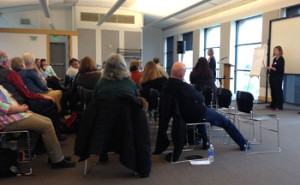by Shane Stroud for EDR Blog.org
Think about the word “environmentalism.” What do you think of? If you’re like me, you think of protecting crystal-blue mountain streams and sandstone slot canyons. For most of us, the environment has always been a place we go to, removed from the cityscape where we spend most of our time, and environmentalism has always been about preserving wilderness, the climate, and other features of the natural world.
Now, think about the word “homelessness.” What comes to mind? Are any of the thoughts and emotions evoked by homelessness similar to those evoked by environmentalism? If you’d asked me this question a year ago, I would have said no. But today I have a different perspective.
Over the course of the last eight months, I’ve had the opportunity to work with a group of University of Utah S.J. Quinney College of Law students and faculty on an assessment of Salt Lake City’s response to homelessness. This Homeless Situation Assessment entailed interviewing individuals who are either affected by homelessness themselves, or who are committed to serving Salt Lake City’s homeless population. (You can read the Assessment report here) Under the direction of Professor Michele Straube of the Wallace Stegner Center’s Environmental Dispute Resolution Program, my classmates and I interviewed homeless individuals and families, government stakeholders, Salt Lake City business owners, non-profit workers, and religious leaders dedicated to helping end homelessness in our community. The end result was a comprehensive overview of the current homeless situation in Salt Lake City.

What does this have to do with environmental dispute resolution? I admit, I asked myself that same question when I started working on the project. Helping our homeless friends and neighbors is certainly important work, although I’d never considered it might be environmental work, let alone environmental dispute resolution.
But what I came to realize over the course of the Assessment is that environmental disputes are not limited to conflicts involving endangered species or coal mines. For many (if not most) of us, the environment in which we spend the greatest amount of time is the city where we live. The streets we walk down, the buses and trains we ride to and from work, the parks we stroll through: this “built” environment is as much in need of protection as the Arctic or the Amazon. Part and parcel to this protection is ensuring our friends and neighbors are able to live in a healthy, vibrant, and supportive community. Ending homelessness is one way to achieve this goal, although there are many different ideas as to how to do so.
The Assessment was a way to get the ball rolling and to get people thinking of how best to go about working towards a solution. By conducting interviews (all of which were kept confidential), members of our community who are working to end homelessness were able to speak freely about what they felt is working and what isn’t. This format also allowed people to express far more than just their feelings about homelessness. They were able to share their feelings about their community and how homelessness had affected them personally. In that way, the Assessment gave those we interviewed an opportunity to look at the problem from a different perspective. For me personally, this new perspective allowed to me realize just how much environmentalism and homelessness are related.
My final experience with the Assessment is perhaps the best illustration of my realization. A couple of weeks ago, some of the stakeholders we’d interviewed participated in a two-day retreat in order to discuss the future of homelessness in Salt Lake City. At this retreat, representatives from Salt Lake City, Salt Lake County, and many homeless service providers met together to discuss how best to help homeless individuals and families in our community. During the meeting, the stakeholders participated in an exercise where they discussed the current response to homelessness, and the barriers to ending homelessness. Not all the stakeholders agreed on the path forward, and at times the meeting was tense. But ultimately, the stakeholders were able to coalesce around a common purpose: improving the lives of all city residents by improving the environment in which we live, work, and interact. With this shared interest in mind, the group was able to move forward and start discussing solutions for the future.
Of course, there remains a lot of work to be done in ending homelessness in both Salt Lake City and around the country. But as we move forward, perhaps we should do so with the goal in mind of improving our built environment, whether that be through affordable housing, healthcare options for homeless individuals and families, or through the support of great organizations like The Road Home, The Fourth Street Clinic, and Catholic Community Services.
So I’ll ask again, what do you think of when you hear the word environmentalism? I think of a city where every person has a place to live, where homeless shelters are temporary as opposed to long-term solutions, where everyone has access to the healthcare services they need, and where each resident of the community has a voice. Oh, and I think of mountain streams and slot canyons, too.
Shane Stroud (2014 JD candidate) earned environmental clinic credit in Fall 2013 by providing interview and analysis assistance for the Homeless Situation Assessment. In April 2014, he facilitated a small group discussion at the Homeless Solutions Retreat. In addition to the environmental clinic, Mr. Stroud has focused his law school scholarship in areas of environmental and natural resources law specific to the West.
